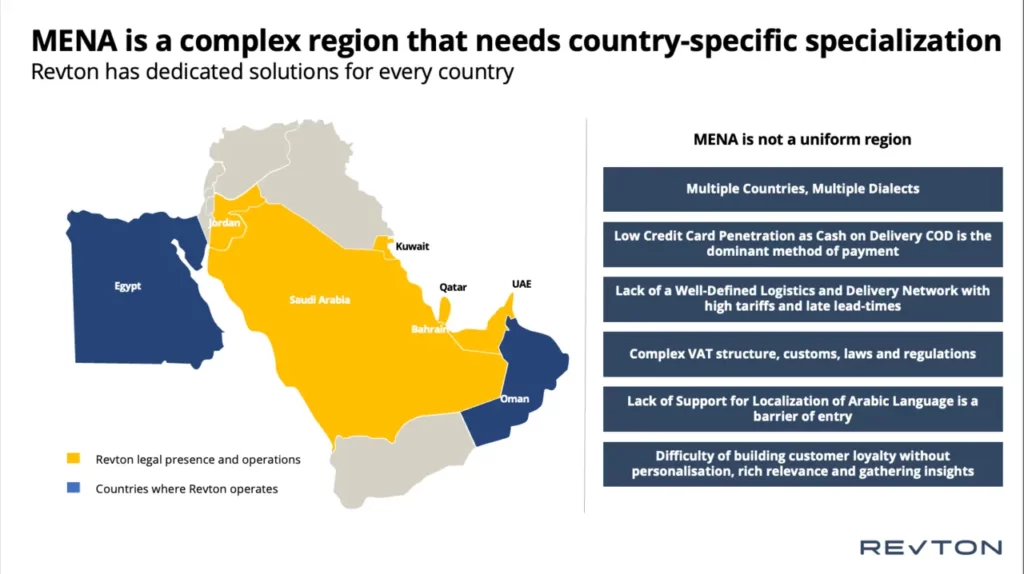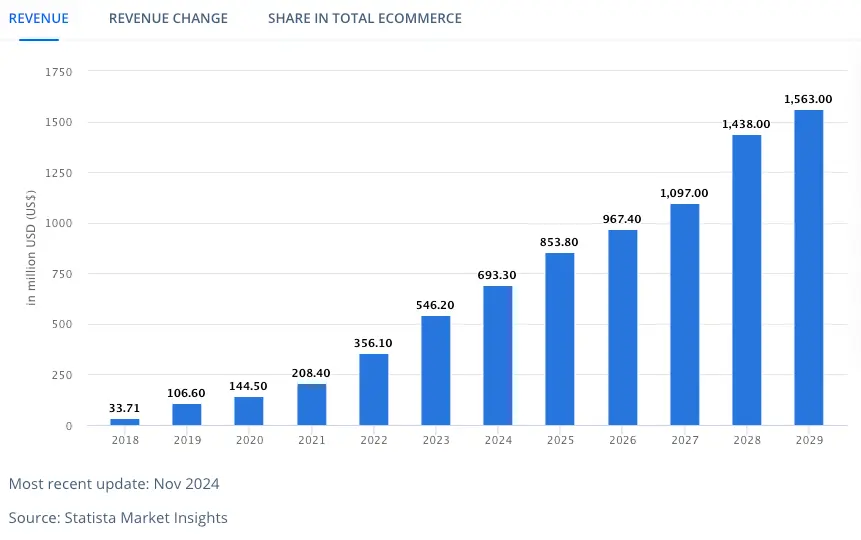E-commerce expansion in the Middle East and North Africa
How does the MENA fashion e-commerce market compare to global markets?
The MENA (Middle East and North Africa) region presents a unique and rapidly growing e-commerce market with distinct characteristics compared to global markets.

Middle East and North Africa E-commerce Growth and Potential
- The MENA e-commerce market has grown at an average rate of 35% year-on-year since 2019. This growth has been accelerated by the COVID-19 pandemic, prompting retailers to focus on this market.
- The e-commerce market figures in 2019 were 28 billion $ and it is expected to reach 55 billion $ in 2022, indicating a substantial increase in a short period. The revenue in the e-commerce market is expected to reach 110.00 billion $ in 2025. Source: Statista.
- The revenue is expected to show a compound annual growth rate (CAGR 2025-2029) of 9.70%, with an estimated market volume of USD 159.30 billion by 2029.
- Online luxury retailers generated over USD 1.2 billion in 2021 in the MENA region.
- The Gulf Cooperation and Development (GCC) countries are particularly attractive because of their young, tech-savvy populations with high disposable incomes and high Internet and smartphone penetration rates.
Nuances and Localization: The Characteristics of the MENA Region
- The MENA region consists of 22 countries with different cultures and consumer behaviors, so it cannot be treated as a single, uniform market.
- Country-specific specialization is required in terms of language, personalization, and marketing campaigns.
- The region uses Arabic, a right-to-left language, which requires specific adaptations.
- The mix of marketing channels is different; for example, Snapchat is a high-performing channel in Kuwait, Saudi Arabia, and Qatar, unlike many other regions. Commercial events include international events such as Black Friday (called White Friday) and local events such as Saudi National Day and Eid.
- Translation should be human-based rather than using simple tools like Google Translate.
- Customer service requires local landlines and Arabic-speaking agents.
- E-commerce platforms must support right-to-left languages, multiple currencies, and inventory locations.
- Payment methods should include options such as KNET (Kuwait), Mada e Sadad (Saudi Arabia), and Benefit Payment (Bahrain).
- It is important to consider what products can cross the border and what is considered prohibited.
- There are also different taxes and duties depending on the country, such as value added tax, customs duties and other taxes.
- Logistics and customer expectations:

The Middle East’s Logistical Challenges, the Fragmentation of Logistics.
- An undeveloped address system requires specific solutions for delivery.
- Cash on Delivery (COD) is still a popular payment method in the region. Approximately 60% of online purchases are completed via COD. Offering COD can present challenges such as high cancellation rates.
- Customers are highly dependent on customer service and expect support through various channels.
- 90% of social media communication is in Arabic.
- A simple and seamless return process with full visibility is essential.
- Success Factors:
Which partner to choose for ecommerce of fashion and luxury companies in the MENA region
To be successful in the MENA region, companies need a partner with local knowledge and expertise.
Localized marketing, content, and customer service are key.
A deep understanding of cultural nuances and consumer behavior is essential.
Revton's approach:
- Revton creates, develops and manages e-commerce businesses in the MENA region for global retailers.
- They offer an end-to-end solution for cross-border growth in the MENA region.
- Services include digital experience creation, value chain localization, marketing optimization, and logistics management.
- They provide all-inclusive localization, country-specific marketing, managed logistics, multiple payment options, and customer support.
- Revton offers a performance-based work model with commission on revenue generated for the client. What location factors impact e-commerce in the Middle East?
- Several localization factors have a significant impact on e-commerce in the Middle East. These factors include marketing, merchandising, translation, customer service, platform considerations, and payment methods. Sources highlight the importance of country-specific specialization due to the region's diverse cultures and consumer behaviors.
Key Location Factors for Success in the MENA Region
- Marketing: Marketing messages and channel mix should be localized. For example, while Snapchat may not be a top channel in other regions, it is highly effective in Kuwait, Saudi Arabia, and Qatar.
- Merchandising: Merchandising events should include both international events, such as White Friday (the Middle Eastern equivalent of Black Friday), and local events, such as Saudi National Day and Eid.
- Translation: Translation should be human-based and culturally relevant, avoiding literal translations from tools like Google Translate. The Middle East uses Arabic, which is written from right to left.
- Customer Service: Local customer service should include local landlines and Arabic-speaking phone numbers.
